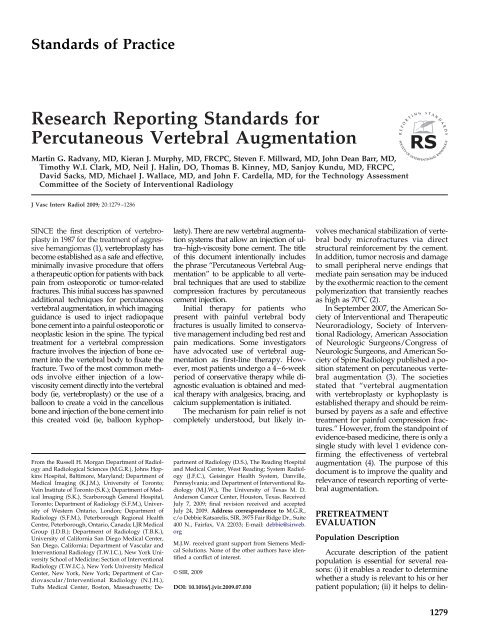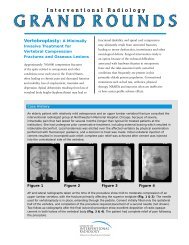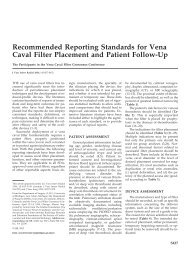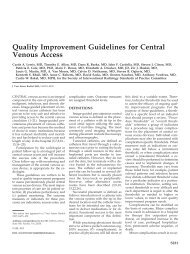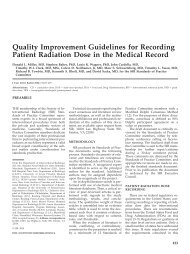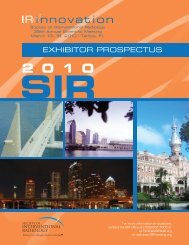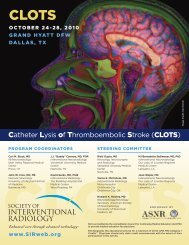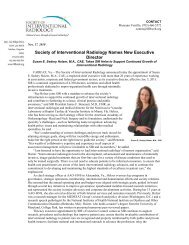Research Reporting Standards for Percutaneous Vertebral ...
Research Reporting Standards for Percutaneous Vertebral ...
Research Reporting Standards for Percutaneous Vertebral ...
You also want an ePaper? Increase the reach of your titles
YUMPU automatically turns print PDFs into web optimized ePapers that Google loves.
<strong>Standards</strong> of Practice<br />
<strong>Research</strong> <strong>Reporting</strong> <strong>Standards</strong> <strong>for</strong><br />
<strong>Percutaneous</strong> <strong>Vertebral</strong> Augmentation<br />
Martin G. Radvany, MD, Kieran J. Murphy, MD, FRCPC, Steven F. Millward, MD, John Dean Barr, MD,<br />
Timothy W.I. Clark, MD, Neil J. Halin, DO, Thomas B. Kinney, MD, Sanjoy Kundu, MD, FRCPC,<br />
David Sacks, MD, Michael J. Wallace, MD, and John F. Cardella, MD, <strong>for</strong> the Technology Assessment<br />
Committee of the Society of Interventional Radiology<br />
J Vasc Interv Radiol 2009; 20:1279–1286<br />
From the Russell H. Morgan Department of Radiology<br />
and Radiological Sciences (M.G.R.), Johns Hopkins<br />
Hospital, Baltimore, Maryland; Department of<br />
Medical Imaging (K.J.M.), University of Toronto;<br />
Vein Institute of Toronto (S.K.); Department of Medical<br />
Imaging (S.K.), Scarborough General Hospital,<br />
Toronto; Department of Radiology (S.F.M.), University<br />
of Western Ontario, London; Department of<br />
Radiology (S.F.M.), Peterborough Regional Health<br />
Centre, Peterborough, Ontario, Canada; LJR Medical<br />
Group (J.D.B.); Department of Radiology (T.B.K.),<br />
University of Cali<strong>for</strong>nia San Diego Medical Center,<br />
San Diego, Cali<strong>for</strong>nia; Department of Vascular and<br />
Interventional Radiology (T.W.I.C.), New York University<br />
School of Medicine; Section of Interventional<br />
Radiology (T.W.I.C.), New York University Medical<br />
Center, New York, New York; Department of Cardiovascular/Interventional<br />
Radiology (N.J.H.),<br />
Tufts Medical Center, Boston, Massachusetts; Department<br />
of Radiology (D.S.), The Reading Hospital<br />
and Medical Center, West Reading; System Radiology<br />
(J.F.C.), Geisinger Health System, Danville,<br />
Pennsylvania; and Department of Interventional Radiology<br />
(M.J.W.), The University of Texas M. D.<br />
Anderson Cancer Center, Houston, Texas. Received<br />
July 7, 2009; final revision received and accepted<br />
July 24, 2009. Address correspondence to M.G.R.,<br />
c/o Debbie Katsarelis, SIR, 3975 Fair Ridge Dr., Suite<br />
400 N., Fairfax, VA 22033; E-mail: debbie@sirweb.<br />
org<br />
M.J.W. received grant support from Siemens Medical<br />
Solutions. None of the other authors have identified<br />
a conflict of interest.<br />
© SIR, 2009<br />
DOI: 10.1016/j.jvir.2009.07.030<br />
SINCE the first description of vertebroplasty<br />
in 1987 <strong>for</strong> the treatment of aggressive<br />
hemangiomas (1), vertebroplasty has<br />
become established as a safe and effective,<br />
minimally invasive procedure that offers<br />
a therapeutic option <strong>for</strong> patients with back<br />
pain from osteoporotic or tumor-related<br />
fractures. This initial success has spawned<br />
additional techniques <strong>for</strong> percutaneous<br />
vertebral augmentation, in which imaging<br />
guidance is used to inject radiopaque<br />
bone cement into a painful osteoporotic or<br />
neoplastic lesion in the spine. The typical<br />
treatment <strong>for</strong> a vertebral compression<br />
fracture involves the injection of bone cement<br />
into the vertebral body to fixate the<br />
fracture. Two of the most common methods<br />
involve either injection of a lowviscosity<br />
cement directly into the vertebral<br />
body (ie, vertebroplasty) or the use of a<br />
balloon to create a void in the cancellous<br />
bone and injection of the bone cement into<br />
this created void (ie, balloon kyphoplasty).<br />
There are new vertebral augmentation<br />
systems that allow an injection of ultra–high-viscosity<br />
bone cement. The title<br />
of this document intentionally includes<br />
the phrase “<strong>Percutaneous</strong> <strong>Vertebral</strong> Augmentation”<br />
to be applicable to all vertebral<br />
techniques that are used to stabilize<br />
compression fractures by percutaneous<br />
cement injection.<br />
Initial therapy <strong>for</strong> patients who<br />
present with painful vertebral body<br />
fractures is usually limited to conservative<br />
management including bed rest and<br />
pain medications. Some investigators<br />
have advocated use of vertebral augmentation<br />
as first-line therapy. However,<br />
most patients undergo a 4–6-week<br />
period of conservative therapy while diagnostic<br />
evaluation is obtained and medical<br />
therapy with analgesics, bracing, and<br />
calcium supplementation is initiated.<br />
The mechanism <strong>for</strong> pain relief is not<br />
completely understood, but likely involves<br />
mechanical stabilization of vertebral<br />
body microfractures via direct<br />
structural rein<strong>for</strong>cement by the cement.<br />
In addition, tumor necrosis and damage<br />
to small peripheral nerve endings that<br />
mediate pain sensation may be induced<br />
by the exothermic reaction to the cement<br />
polymerization that transiently reaches<br />
as high as 70°C (2).<br />
In September 2007, the American Society<br />
of Interventional and Therapeutic<br />
Neuroradiology, Society of Interventional<br />
Radiology, American Association<br />
of Neurologic Surgeons/Congress of<br />
Neurologic Surgeons, and American Society<br />
of Spine Radiology published a position<br />
statement on percutaneous vertebral<br />
augmentation (3). The societies<br />
stated that “vertebral augmentation<br />
with vertebroplasty or kyphoplasty is<br />
established therapy and should be reimbursed<br />
by payers as a safe and effective<br />
treatment <strong>for</strong> painful compression fractures.”<br />
However, from the standpoint of<br />
evidence-based medicine, there is only a<br />
single study with level 1 evidence confirming<br />
the effectiveness of vertebral<br />
augmentation (4). The purpose of this<br />
document is to improve the quality and<br />
relevance of research reporting of vertebral<br />
augmentation.<br />
PRETREATMENT<br />
EVALUATION<br />
Population Description<br />
Accurate description of the patient<br />
population is essential <strong>for</strong> several reasons:<br />
(i) it enables a reader to determine<br />
whether a study is relevant to his or her<br />
patient population; (ii) it helps to delin-<br />
1279
1280 • <strong>Research</strong> <strong>Reporting</strong> <strong>Standards</strong>: <strong>Percutaneous</strong> <strong>Vertebral</strong> Augmentation October 2009 JVIR<br />
eate which patient subsets are likely to<br />
benefit from the intervention being described;<br />
and (iii) it facilitates meaningful<br />
comparison with other studies describing<br />
patient cohorts who were treated<br />
with the same or different medical, surgical,<br />
or interventional therapies. The<br />
main indications <strong>for</strong> vertebral augmentation<br />
include osteoporotic compression<br />
fractures (5), hematologic malignancies<br />
such as multiple myeloma and lymphoma,<br />
metastatic disease (6,7), and<br />
symptomatic benign tumors of the<br />
spine, particularly hemangiomas (8).<br />
Osteoporotic Compression Fractures<br />
Postmenopausal women represent<br />
the principal group at risk of osteoporotic<br />
compression fractures. It is estimated<br />
that as many as 50% of postmenopausal<br />
women will experience an<br />
osteoporosis-related fracture in their<br />
lifetime (9). <strong>Vertebral</strong> compression fracture<br />
is the most frequent fracture, occurring<br />
in 25% of the osteoporotic population.<br />
Additional well defined risk<br />
factors include age, cigarette smoking,<br />
ethnicity, and early menopause. Other<br />
groups at risk include patients receiving<br />
chronic steroid therapy, patients with<br />
renal failure, and individuals with prolonged<br />
immobilization (10).<br />
Painful compression fractures may<br />
result in a marked decrease in physical<br />
activity and/or bed rest, which can lead<br />
to various complications including<br />
physical deconditioning, lung atelectasis<br />
and pneumonia, deep vein thrombosis,<br />
and pulmonary embolism. <strong>Vertebral</strong><br />
compression fractures represent one of<br />
the leading causes of admission to nursing<br />
homes (11). Medications used <strong>for</strong><br />
pain control in patients with osteoporotic<br />
compression fractures include narcotics<br />
and nonsteroidal antiinflammatory<br />
drugs. Although commonly<br />
prescribed, these medications are not<br />
without complications. Ulcers can be<br />
documented by endoscopy in as many<br />
as 40% of chronic nonsteroidal antiinflammatory<br />
drug users (12). Serious<br />
nonsteroidal antiinflammatory drug–<br />
induced gastrointestinal complications,<br />
such as hemorrhage, per<strong>for</strong>ation, and<br />
death, occur collectively in as many as<br />
1.5% of patients per year (13). In a review<br />
of patients receiving opioid agents<br />
<strong>for</strong> noncancer pain, approximately 80%<br />
of patients experienced at least one adverse<br />
event, with constipation (41%),<br />
nausea (32%), and somnolence (29%)<br />
being most common (14).<br />
In cases in which there is significant<br />
spinal cord compression or neurologic<br />
deficit associated with a compression<br />
fracture, patients should<br />
receive surgical treatment with anterior<br />
decompression and fusion followed<br />
by posterior segmental instrumentation<br />
and fusion. However,<br />
osteopenic adjacent vertebrae provide<br />
a poor anchor <strong>for</strong> surgical hardware<br />
(15). These procedures represent<br />
significant interventions <strong>for</strong><br />
fragile patients, who are often poor<br />
surgical candidates with appreciably<br />
increased peri- and postoperative<br />
morbidity and mortality.<br />
Long-term medical management and<br />
prevention of osteoporosis relies on adequate<br />
dietary calcium intake, calcium<br />
and vitamin D supplementation,<br />
weight-bearing exercise and estrogen<br />
replacement therapy. Bisphosphonates<br />
and calcitonin are effective in bone augmentation<br />
when prolonged therapy is<br />
used, although they do not provide pain<br />
relief. Prolonged therapy is required,<br />
and some medications may be difficult<br />
to tolerate because of side effects.<br />
Malignancies<br />
In North America, vertebral augmentation<br />
has not been as widely applied to<br />
the treatment of patients with nonosteoporotic<br />
vertebral lesions. However, this<br />
patient population may benefit considerably,<br />
with rapid and durable reduction<br />
in vertebral pain after vertebral<br />
augmentation. Metastatic lesions are the<br />
most common tumors of the spine, but<br />
hematologic malignancies such as multiple<br />
myeloma and lymphoma may also<br />
frequently involve multiple vertebral<br />
levels. Patients usually present with severe<br />
pain secondary to osseous involvement,<br />
with or without vertebral collapse.<br />
Pain can also be a result of spinal<br />
cord and/or nerve root compression.<br />
Conventional therapy <strong>for</strong> malignant<br />
disease consists of bed rest, bracing, antiinflammatory<br />
or narcotic medication,<br />
and radiation therapy. These conservative<br />
options, not dissimilar from the<br />
management of osteoporotic compression<br />
fractures, may be associated with<br />
the same type of complications, ie, atelectasis<br />
and pneumonia, deep vein<br />
thrombosis, and pulmonary embolism.<br />
Surgical options consist of interventions<br />
such as corpectomy or cage placement,<br />
with significant postprocedural recovery<br />
periods and high morbidity and<br />
mortality rates in patients who often<br />
have limited life expectancies. In addition,<br />
multifocal vertebral lesions are<br />
common and may contraindicate surgery.<br />
There<strong>for</strong>e, <strong>for</strong> many patients, vertebral<br />
augmentation may be the treatment<br />
of choice.<br />
<strong>Vertebral</strong> augmentation is best indicated<br />
in patients who present with a<br />
severe, focal, and mechanical back pain<br />
related to a vertebral collapse without<br />
epidural involvement. In the absence of<br />
spinal cord compression or epidural involvement,<br />
partial osteolysis of the posterior<br />
wall of the vertebral body is not a<br />
contraindication (7). Preventive treatment<br />
of osteolytic lesions at high risk of<br />
vertebral collapse in asymptomatic patients<br />
may be appropriate. <strong>Vertebral</strong><br />
augmentation is rarely indicated at the<br />
cervical and cervicothoracic junction but<br />
may be of value when surgery is contraindicated.<br />
The second and third cervical<br />
vertebrae can be approached transorally;<br />
the other cervical vertebra can be<br />
treated from the anterolateral approach.<br />
Prophylactic vertebral augmentation in<br />
asymptomatic patients has been described<br />
anecdotally but is not widely<br />
accepted.<br />
Hemangioma<br />
<strong>Vertebral</strong> hemangiomas are benign<br />
lesions usually incidentally discovered<br />
on magnetic resonance (MR) imaging<br />
studies of the spine per<strong>for</strong>med <strong>for</strong> back<br />
pain. They are generally confined to the<br />
vertebral body and characterized by a<br />
bright T1- and T2-weighted signal. Painful,<br />
destructive vertebral body hemangiomas<br />
are relatively rare. However, they<br />
may cause pain related to fracture,<br />
mass effect with thecal sac compression,<br />
or neural <strong>for</strong>aminal compromise.<br />
<strong>Vertebral</strong> hemangiomas are<br />
amenable to vertebroplasty; the first<br />
report of vertebroplasty ever per<strong>for</strong>med<br />
was <strong>for</strong> a hemangioma (1).<br />
Baseline Clinical Evaluation<br />
The pretreatment clinical status of<br />
spinal disease in the study group should<br />
be characterized. Levels of pain and<br />
functional ability/disability should be<br />
accurately described so that the results<br />
of any intervention can be evaluated.<br />
The visual analog scale is a well established<br />
method of documenting patient
Volume 20 Number 10<br />
Radvany et al • 1281<br />
pain levels (16), and should be used to<br />
document pain levels both be<strong>for</strong>e and<br />
following interventions. The Oswestry<br />
Disability Index (17,18) and Roland<br />
Morris Disability Questionnaire (19) are<br />
well established condition-specific outcome<br />
measures used in the management<br />
of low back pain. The Short<br />
Form–36 (Medical Outcomes Trust, Boston,<br />
Massachusetts) is a <strong>for</strong>m comprising<br />
36 questions that yields an eightscale<br />
profile of scores as well as physical<br />
and mental health summary measures.<br />
It is a generic measure, as opposed to<br />
one that targets a specific age, disease,<br />
or treatment group (20). Accordingly,<br />
the Short Form–36 has been useful in<br />
comparing general and specific populations,<br />
comparing the relative burden of<br />
diseases, differentiating the health benefits<br />
produced by a wide range of different<br />
treatments, and screening individual<br />
patients (21).<br />
On physical examination, percussion<br />
of the spine typically elicits pain within<br />
one to two vertebral levels of the compression<br />
fracture. The amount of compression<br />
of a vertebral body frequently<br />
bears little relation to degree of pain or<br />
the suitability <strong>for</strong> vertebroplasty. In patients<br />
with multiple vertebral compression<br />
fractures, localization of the symptomatic<br />
level may be difficult. In such<br />
cases, bone scan or MR imaging may be<br />
helpful.<br />
Diagnostic studies usually include<br />
anteroposterior and lateral plain radiographs<br />
of the spine and/or MR imaging,<br />
which has the advantage of documenting<br />
additional spine conditions<br />
and vertebral levels that may contribute<br />
to the pain syndrome, in particular spinal<br />
degenerative disease. MR imaging<br />
provides a better evaluation of the degree<br />
of spinal canal compromise and/or<br />
spinal cord involvement, and may suggest<br />
underlying malignant disease<br />
based on the presence of soft tissue or<br />
epidural extension. Some patients may<br />
have contraindications to MR imaging<br />
such as a pacemaker or spinal instrumentation<br />
that compromises image<br />
quality. In these patients, nuclear medicine<br />
bone scans can help localize symptomatic<br />
levels amenable to treatment<br />
(22). Painful vertebral bodies may not<br />
demonstrate edema on short inversion<br />
recovery MR imaging, but the edema<br />
state should be reported. MR imaging<br />
protocols should be described in detail.<br />
Recommendations<br />
The number of patients and the number<br />
of treatments per patient must be<br />
reported. A basic demographic description<br />
must be provided, including age,<br />
sex, and ethnicity. Number of participating<br />
institutions and the number per<br />
institution should be reported. Symptom<br />
duration be<strong>for</strong>e vertebral augmentation<br />
must be reported. Previous and<br />
concomitant medical/other treatments<br />
must be described. Comorbid conditions<br />
and risk factors should be documented,<br />
as this may yield important insights<br />
into patient populations that may<br />
benefit, or may have increased morbidity,<br />
as a result of interventions intended<br />
to improve quality of life. A baseline<br />
assessment of pain and disability with<br />
validated measurement tools must be<br />
reported. The same measurement tools<br />
should be used <strong>for</strong> follow-up so that<br />
change over time can be identified and<br />
reported. Because there are different<br />
disease processes that predispose patients<br />
to vertebral compression fractures,<br />
it is important that these distinct<br />
patient populations are recognized. The<br />
etiology of compression fracture (eg, osteoporosis,<br />
hemangioma, malignancy)<br />
should be documented, as these different<br />
patient populations have different<br />
characteristics. The purpose of treatment<br />
(eg, pain relief, prophylaxis)<br />
should be documented. The study inclusion<br />
and exclusion criteria must be<br />
stated, and the method of treatment<br />
assignment must be reported.<br />
Imaging modalities used <strong>for</strong> evaluation<br />
must be documented. The grade of<br />
compression fracture, as determined by<br />
imaging, should be documented. Fracture<br />
characteristics may yield in<strong>for</strong>mation as to<br />
fractures more prone to complication and<br />
thus a uni<strong>for</strong>m terminology <strong>for</strong> grading<br />
of compression fractures should be<br />
used. The system developed by Genant<br />
et al (23) has been used as a grading<br />
system in several studies, such as that of<br />
Klazen et al (24). According to this semiquantitative<br />
approach, each vertebra is<br />
assigned a grade of 0–3, whereby a<br />
grade of 0 (ie, normal) indicates no reduction<br />
in vertebral body height, grade<br />
1 (ie, mild) indicates a reduction in vertebral<br />
body height of 20%–25%, grade 2<br />
(ie, moderate) indicates a reduction of<br />
25%–40%, and grade 3 (severe) indicates<br />
a reduction of more than 40%. For<br />
patients with osteolytic metastasis the<br />
presence of pathologic fractures as well<br />
as the degree of osteolytic involvement<br />
of the vertebral body should be described.<br />
Trumm et al (25) have devised a<br />
grading system that quantifies osteolytic<br />
destruction of the vertebral body, posterior<br />
cortical wall and spinal canal, and<br />
the outer cortical wall in increments<br />
of 25%.<br />
TREATMENT DESCRIPTION<br />
Radiologic imaging has been a critical<br />
part of vertebral augmentation from<br />
its inception. Most procedures are per<strong>for</strong>med<br />
with use of single-plane or biplane<br />
fluoroscopic guidance <strong>for</strong> needle<br />
placement and to monitor bone cement<br />
injection. The use of computed tomography<br />
(CT) has been described (25,26)as<br />
well as cone-beam C-arm CT (27).<br />
Description of Technique<br />
Polymethylmethacrylate is currently<br />
the most commonly used cement <strong>for</strong><br />
vertebral augmentation. Most complications<br />
are related to extravasations of cement<br />
into the spinal canal and venous<br />
system. Various polymethylmethacrylate<br />
<strong>for</strong>mulations have different properties<br />
of setting time, polymerization temperature,<br />
and strength. The cement<br />
properties affect cement distribution<br />
and handling, as well as the means by<br />
which the cement is injected through the<br />
needle and even the size of needle<br />
through which the cement can be injected.<br />
Current polymethylmethacrylate<br />
<strong>for</strong>mulations have largely overcome<br />
many of these limitations; however,<br />
polymethylmethacrylate is neither biodegradable<br />
nor osteoconductive and<br />
thus becomes a permanent implant that<br />
may interfere in the natural remodeling<br />
process of bone (28). Cements containing<br />
calcium phosphate, calcium sulfate<br />
hydroxyapatite, as well as composite<br />
resins are being developed to address<br />
these issues (29).<br />
Because of the systemic nature of osteoporosis<br />
and possible altered mechanics<br />
of the spine after vertebral augmentation,<br />
patients are at risk <strong>for</strong> the<br />
development of fractures at adjacent<br />
levels (30,31). Different cement compositions<br />
may also reduce the risk of fractures<br />
at adjacent levels by more closely<br />
approximating the biomechanical properties<br />
of bone.<br />
<strong>Vertebral</strong> augmentation is frequently<br />
per<strong>for</strong>med via a transpedicular route/<br />
approach, although other approaches
1282 • <strong>Research</strong> <strong>Reporting</strong> <strong>Standards</strong>: <strong>Percutaneous</strong> <strong>Vertebral</strong> Augmentation October 2009 JVIR<br />
Table 1<br />
SIR <strong>Standards</strong> of Practice Committee Classification of Complications by Outcome<br />
Minor Complications<br />
A. No therapy, no consequence.<br />
B. Nominal therapy, no consequence; includes overnight admission (up to 23 hours)<br />
<strong>for</strong> observation only.<br />
Major Complications<br />
C. Require therapy, minor hospitalization (24 h, but 48 h).<br />
D. Require major therapy, unplanned increase in level of care, prolonged<br />
hospitalization (48 h).<br />
E. Permanent adverse sequelae.<br />
F. Death.<br />
can be used, particularly in the cervical<br />
region. The choice of needle size may be<br />
influenced by the planned approach to<br />
the vertebral body. The size of the needle<br />
may also impact extravasation along<br />
the needle tract, as well as associated<br />
complications with needle placement.<br />
The number of levels treated also appears<br />
to be associated with development<br />
of complications (32). There are<br />
reports of successful vertebral augmentation<br />
of more than three to five levels in<br />
one sitting (33,34).<br />
Vertebroplasty and kyphoplasty are<br />
the two most common techniques <strong>for</strong><br />
vertebral augmentation at this time.<br />
Both techniques have been shown to<br />
stabilize vertebral compression fracture,<br />
but there is controversy as to which<br />
technique is superior. It is important to<br />
note that they are not mutually exclusive<br />
procedures, and one procedure<br />
may be preferable to the other depending<br />
on the location of the vertebral body<br />
to be treated and the nature of the abnormality.<br />
The use of vertebroplasty or<br />
kyphoplasty has been reported <strong>for</strong> osteoporotic<br />
vertebral compression fractures<br />
(35,36), as well as vertebral compression<br />
fractures associated with<br />
malignancy (37). Vertebroplasty is a<br />
somewhat simpler procedure, with<br />
fewer steps; after needle placement, cement<br />
is injected through the needle. Kyphoplasty<br />
requires several steps be<strong>for</strong>e<br />
the injection of cement. These additional<br />
steps include drilling a path into the<br />
vertebral body <strong>for</strong> the balloon, inflating<br />
a balloon to compact the bone and create<br />
a potential space, followed by injection<br />
of the bone cement. The larger size<br />
of the needle used in kyphoplasty may<br />
limit its application. All procedural<br />
steps, rationale <strong>for</strong> their choice, and procedural<br />
endpoints must be described.<br />
The most significant difference between<br />
the procedures is the restoration<br />
of lost vertebral body height, thus reducing<br />
kyphosis at the treated level; and<br />
the associated potential long-term complications<br />
(38–40). Another potential<br />
benefit to kyphoplasty is the lower reported<br />
rate of cement extrusion (41). It<br />
has been shown that kyphoplasty may<br />
seal osseous defects and venous pathways,<br />
thereby preventing cement from<br />
leaking (42).<br />
The patient’s overall health and comorbid<br />
conditions will affect the type of<br />
sedation required to per<strong>for</strong>m vertebral<br />
augmentation. Many patients can tolerate<br />
vertebral augmentation with the use<br />
of sedation alone; however, those with<br />
poor cardiopulmonary status or those<br />
undergoing vertebral augmentation of<br />
cervical vertebrae may require general<br />
anesthesia.<br />
Adjunctive procedures have been applied<br />
to patients with malignancy. Radiation<br />
therapy has been used in patients<br />
with spinal metastasis. In some cases,<br />
tumors are unresponsive, or patients are<br />
not offered vertebroplasty until they receive<br />
maximal radiation. There are those<br />
who advocate vertebral augmentation<br />
be<strong>for</strong>e radiation therapy as it has been<br />
shown that treatment of neoplasms is<br />
not affected by the presence of cement,<br />
nor is cement affected by radiation (43).<br />
In fact, it has been shown using a human<br />
cadaver model that the delivered<br />
dose to the vertebral body is increased<br />
after vertebroplasty (44). Small series<br />
have included adjunctive procedures<br />
such as radiofrequency ablation <strong>for</strong> patients<br />
with spinal metastasis (45,46). The<br />
use and benefit of these procedures requires<br />
further study because additional<br />
treatments may increase costs.<br />
Recommendations<br />
The imaging modalities used to per<strong>for</strong>m<br />
vertebral augmentation should<br />
be described. Patient positioning, the<br />
route/approach, and the point of needle<br />
entry into the vertebral body should be<br />
described. The number of needle placements<br />
<strong>for</strong> each vertebra and the use of<br />
unipedicular, bipedicular, or extrapedicular<br />
approaches must be reported.<br />
The type, size, method of use, and manufacturer<br />
of all devices used, including<br />
needles, catheters, and balloons, must<br />
be reported. The type of sedation used<br />
and patient monitoring should be reported.<br />
When general anesthesia is<br />
used, the reason <strong>for</strong> its use should be<br />
described. The manufacturer of the cement,<br />
composition of the cement,<br />
method of delivery, working time, use<br />
of additives (eg, to increase opacity),<br />
and volume delivered must be reported.<br />
The methods used to choose technical<br />
and procedural aspects and endpoints<br />
(eg, approach to the vertebra, amount of<br />
cement injected, detection of cement<br />
leakage, degree of balloon inflation)<br />
must be specified. Procedural elements<br />
(eg, patient positioning, imaging modality)<br />
may influence the overall procedure<br />
time and fluoroscopy time (as well as<br />
radiation dose), and these should be<br />
documented (47). The number of levels<br />
treated as well as their location must be<br />
reported. Objective measurements of<br />
kyphosis and vertebral body height improvement<br />
should be reported according<br />
to accepted measures such as the<br />
Cobb angle and Genant score (23). Adjunctive<br />
procedures such as epidural or<br />
sacroiliac joint injections, radiofrequency<br />
ablation, and radiation therapy,<br />
when used in conjunction with vertebral<br />
augmentation, should be reported. Use<br />
of local and systemic medications, such<br />
as intravenous antibiotics, should be reported.<br />
Whether patients were treated<br />
according to the originally intended<br />
protocol should be reported.<br />
OUTCOMES ASSESSMENT<br />
The goal of vertebral augmentation is<br />
to improve patients’ quality of life by<br />
relieving pain and returning patients to<br />
their baseline level of activity be<strong>for</strong>e the<br />
onset of pain related to a vertebral compression<br />
fracture or neoplastic/tumoral<br />
destruction of a vertebral body. As a<br />
result of the differing underlying disease<br />
processes (eg, osteoporosis, malignancy,<br />
hemangioma), outcome measures<br />
will be different and the follow-up<br />
of these patients may be limited by life<br />
expectancy. To fully evaluate the out-
Volume 20 Number 10<br />
Radvany et al • 1283<br />
Table 2<br />
Summary of <strong>Reporting</strong> <strong>Standards</strong><br />
Category<br />
Population description<br />
Basic demographic data<br />
Etiology of fracture<br />
Purpose of treatment<br />
Grade of vertebral compression fracture<br />
Treatments be<strong>for</strong>e vertebral augmentation<br />
Symptom duration be<strong>for</strong>e vertebral augmentation<br />
Pain assessment<br />
Disability evaluation (eg, VAS, ODI, RMDQ, SF-12, SF-36)<br />
Quality of life<br />
Risk factors/comorbidities<br />
Imaging modalities <strong>for</strong> workup<br />
Inclusion/exclusion criteria<br />
Method of treatment assignment<br />
Treatment description<br />
Imaging equipment<br />
Patient position<br />
Sedation/general anesthesia<br />
Route/approach to vertebra<br />
Devices used, including manufacturer<br />
Location and number of levels treated per session<br />
Procedure time<br />
Type of cement and additives<br />
Method of cement injection<br />
Amount injected per level<br />
Adjunctive procedures<br />
Outcomes assessment<br />
Technical and clinical success<br />
Imaging follow-up: type, timing, and results<br />
Clinical follow-up: type, timing, and results<br />
Complications, classified by SIR outcomes scale<br />
Pain assessment<br />
Disability evaluation<br />
Quality of life<br />
Height restoration and kyphosis improvement<br />
New compression fractures and locations<br />
Analysis<br />
Study design<br />
Data collection<br />
Institutional review board approval<br />
Statistical analysis<br />
Intent to treat/per protocol<br />
Cost analysis<br />
Recommendation<br />
Required<br />
Required<br />
Required<br />
Required<br />
Required<br />
Required<br />
Required<br />
Required<br />
Recommended<br />
Required<br />
Required<br />
Required<br />
Required<br />
Required<br />
Required<br />
Required<br />
Required<br />
Required<br />
Required<br />
Required<br />
Required<br />
Required<br />
Required<br />
Required<br />
Required<br />
Required<br />
Required<br />
Required<br />
Required<br />
Required<br />
Recommended<br />
Recommended<br />
Required<br />
Required<br />
Required<br />
Required<br />
Required<br />
Required<br />
Recommended<br />
Note.—ODI Oswestry Disability Index; RMDQ Roland Morris Disability<br />
Questionnaire; SF-12 Short Form-12; SF-36 Short Form-36; VAS visual analog<br />
scale.<br />
comes of vertebral augmentation, it is<br />
necessary to assess the safety and efficacy<br />
of vertebral augmentation, as well<br />
as resource utilization.<br />
The Society of Interventional Radiology<br />
(SIR) Quality Improvement Guidelines<br />
<strong>for</strong> <strong>Percutaneous</strong> Vertebroplasty<br />
provide and list of complications associated<br />
with vertebroplasty and suggested<br />
thresholds. Described complications include<br />
death, paralysis, hypotension,<br />
bleeding, infection, device breakage, cement<br />
leakage (including location of<br />
leakage), and pulmonary embolism (including<br />
fat and cement). Major complications<br />
occur in fewer than 1% of patients<br />
treated <strong>for</strong> compression fractures<br />
secondary to osteoporosis and in fewer<br />
than 5% of treated patients with metastatic<br />
involvement (48). Published rates<br />
may vary with patient selection, as well<br />
as the methods used to detect complications:<br />
<strong>for</strong> example, routine use of postoperative<br />
chest CT may increase reported<br />
rates of cement embolism (49).<br />
Methods used to diagnose complications<br />
(ie, imaging and/or clinical methods)<br />
should be reported. The type of<br />
imaging equipment employed during<br />
per<strong>for</strong>mance of vertebral augmentation,<br />
cement properties, number of levels<br />
treated, and underlying disease process<br />
have all been implicated in contributing<br />
to complications. SIR standards of practice<br />
<strong>for</strong> classification of complications by<br />
outcome provide a uni<strong>for</strong>m means <strong>for</strong><br />
classifying and reporting complications<br />
(Table 1). Adverse events should be recorded<br />
at standard intervals such as 24<br />
hours and 30 days. All complications,<br />
both symptomatic and asymptomatic,<br />
must be classified and reported.<br />
Technical success should be considered<br />
placement of the needle and/or<br />
device into the vertebral body with injection<br />
of enough cement to stabilize the<br />
vertebral body. As this last element is<br />
subjective, it will vary with each level<br />
treated and will be influenced by the<br />
size of the vertebral body. It is there<strong>for</strong>e<br />
important to define technical success<br />
and document this on a per-procedure<br />
basis. Clinical success is defined as the<br />
achievement of significant pain relief<br />
and/or improved mobility as measured<br />
by validated measurement<br />
tools. Threshold rates <strong>for</strong> clinical success<br />
have been suggested as 80% <strong>for</strong><br />
patients with osteoporosis and 50%–<br />
60% <strong>for</strong> patients with neoplastic lesions<br />
(48). Definitions of technical and<br />
clinical success were specified in the<br />
studies of Knight (50) and Kallmes<br />
et al (51); authors may choose to use<br />
these.<br />
The immediate and short-term (1<br />
year) benefit of vertebroplasty (52–54)<br />
and kyphoplasty (4) have been shown<br />
by several studies. Postprocedural pain,<br />
disability, and quality of life should be<br />
measured with repetition of the preprocedural<br />
validated tools to compare clinical<br />
status be<strong>for</strong>e and after treatment<br />
with vertebral augmentation. These<br />
measures should be administered at set<br />
time intervals after vertebral augmentation<br />
as specified in the study protocol.<br />
Obtaining in<strong>for</strong>mation about the cost<br />
of a procedure is typically limited to<br />
hospital charges. Un<strong>for</strong>tunately, this<br />
does not take into account the productivity<br />
lost by patients and their immediate<br />
families if they are the primary caretakers.<br />
Most patients undergo several<br />
weeks of medical therapy be<strong>for</strong>e vertebral<br />
augmentation. Cost savings may be
1284 • <strong>Research</strong> <strong>Reporting</strong> <strong>Standards</strong>: <strong>Percutaneous</strong> <strong>Vertebral</strong> Augmentation October 2009 JVIR<br />
found because of the shorter recovery<br />
period associated with a minimally invasive<br />
procedure compared with medical<br />
or surgical treatments. Rigorous<br />
analysis of costs should include in hospital<br />
costs, costs of complications, and<br />
costs of long-term care, monitoring, and<br />
treatment.<br />
Recommendations<br />
Technical/anatomic success must be<br />
defined and rates reported. Complications<br />
should be defined as minor or major<br />
and reported at standardized intervals,<br />
on a per-patient basis, according to<br />
the SIR criteria. Treatment efficacy, including<br />
the primary outcome measure(s),<br />
must be defined and rates reported.<br />
Improvement in patient pain,<br />
disease/symptom severity, disability,<br />
and quality of life are key elements in<br />
reporting outcomes after vertebral augmentation.<br />
Quantitative and clinically<br />
meaningful measures of these outcomes<br />
must be used. Authors should specify<br />
which outcomes measures were collected<br />
prospectively and which were<br />
collected retrospectively. The follow-up<br />
protocol should specify the type and<br />
timing of follow-up imaging, and the<br />
timing and nature of clinical follow-up<br />
and personnel responsible <strong>for</strong> this. Suggested<br />
follow-up intervals are shortterm<br />
(ie, 1 year), midterm (ie, 1–3 y),<br />
and long-term (ie, 3 y).<br />
COMPARISON BETWEEN<br />
TREATMENT GROUPS<br />
The randomized clinical trial is the<br />
criterion standard of clinical research<br />
and is the methodology of choice <strong>for</strong><br />
determining the safety and efficacy of<br />
vertebral augmentation treatments and<br />
<strong>for</strong> comparing them with other percutaneous,<br />
surgical, and medical therapies<br />
(55). However, it is recognized that most<br />
studies will be of lesser methodologic<br />
rigor as a result of practical reasons such<br />
as cost, patient recruitment, and/or ethical<br />
considerations. Randomized trials<br />
should be per<strong>for</strong>med in accordance with<br />
the guidelines described by Begg et al (55).<br />
Reports must indicate whether a<br />
study is single-center or multicenter and<br />
sponsored, and if so, by whom and<br />
whether it was per<strong>for</strong>med under the aegis<br />
of the United States Food and Drug<br />
Administration or another regulatory<br />
body. The role of the sponsor in funding,<br />
data management, and data analysis,<br />
among other functions, should be<br />
described. The institutional review<br />
board status must be provided. The<br />
study design, sample size, statistical<br />
power, and statistical analyses must be<br />
reported. Consultation with a statistician<br />
in the methodology of the study<br />
design and statistical analysis is recommended<br />
be<strong>for</strong>e starting the study.<br />
Primary statistical analyses should be<br />
reported based on intent-to-treat and<br />
per-protocol analyses. With an intent-totreat<br />
approach, subjects are analyzed<br />
with the group to which they were randomized<br />
whether they received the<br />
treatment or dropped out of the study.<br />
A per-protocol analysis considers only<br />
those patients who actually received the<br />
intended treatment. Discussions of significance<br />
should incorporate the study<br />
design limitations. If the study conclusions<br />
are based on analysis of surrogate<br />
outcomes, they should be tempered accordingly.<br />
Authors should avoid drawing<br />
conclusions not clearly supported<br />
by the data; if alternate interpretations<br />
of the data are possible, they should be<br />
discussed.<br />
CONCLUSION<br />
Published studies on vertebral augmentation<br />
have been limited by nonstandardized<br />
reporting, lack of longterm<br />
follow-up, and use of surrogate<br />
outcome measures. It is the purpose of<br />
these reporting standards to bring<br />
greater uni<strong>for</strong>mity to vertebral augmentation<br />
research reported in the radiology<br />
literature. A summary of the requirements<br />
and recommendations <strong>for</strong> reporting<br />
are provided in Table 2. Some of<br />
these requirements and recommendations<br />
may be more applicable to large<br />
trials than small case series. Authors are<br />
also encouraged to consult the guidance<br />
<strong>for</strong> vertebral augmentation published<br />
by the United States Food and Drug<br />
Administration in 2004 (56).<br />
Acknowledgments: Dr. Martin G. Radvany<br />
authored the first draft of this document<br />
and served as topic leader during the<br />
subsequent revisions of the draft. Dr. Steve<br />
Millward is chair of the SIR Technology Assessment<br />
Committee and Dr. John Cardella<br />
is SIR <strong>Standards</strong> Division Councilor. Other<br />
members of the Technology Assessment<br />
Committees who participated in the development<br />
of this clinical practice guideline are<br />
(listed alphabetically): Mark Baerlocher, Filip<br />
Banovac, MD, John Dean Barr, MD, Gary J.<br />
Becker, MD, Carl M. Black, MD, John J.<br />
Borsa, MD, Matthew R. Callstrom, MD,<br />
Drew M. Caplin, MD, Thomas M. Carr, MD,<br />
Bairbre Connolly, MD, John J. Connors, III,<br />
MD, William B. Crenshaw, MD, Michael D.<br />
Dake, MD, Aron Michael Devane, MD, B.<br />
Janne D’Othee, MD, Salomao Faintuch, MD,<br />
Ron C. Gaba, MD, Joseph Gemmete, MD,<br />
Debra Ann Gervais, MD, Craig B. Glaiberman,<br />
MD, S. Nahum Goldberg, MD, Clement<br />
J. Grassi, MD, Randall T. Higashida, MD,<br />
Michael D Kuo, MD, John A. Lippert, MD,<br />
Llewellyn V. Lee, MD, Louis G. Martin,<br />
MD, Philip M. Meyers, MD, David A. Phillips,<br />
MD, Dheeraj K. Rajan, MD, Stefanie M.<br />
Rosenberg, PA , David A. Rosenthal, PA,<br />
James E. Silberzweig, MD, Richard Towbin,<br />
MD, John York, MD, Curtis W. Bakal, MD,<br />
Curtis A. Lewis, MD, MBA, JD, Kenneth S.<br />
Rholl, MD.<br />
References<br />
1. Galibert P, Deramond H, Rosat P, et al.<br />
Preliminary note on the treatment of vertebral<br />
angioma by percutaneous acrylic<br />
vertebroplasty. Neurochirurgie 1987; 33:<br />
166–168. [French]<br />
2. Deramond H, Wright NT, Belkoff SM.<br />
Temperature elevation caused by bone<br />
cement polymerization during vertebroplasty.<br />
Bone 1999; 25(suppl):S17–S21.<br />
3. Jensen ME, McGraw JK, Cardella JF, Hirsch<br />
JA. Position statement on percutaneous<br />
vertebral augmentation: a consensus<br />
statement developed by the<br />
American Society of Interventional and<br />
Therapeutic Neuroradiology, Society of<br />
Interventional Radiology, American Association<br />
of Neurological Surgeons/<br />
Congress of Neurological Surgeons, and<br />
American Society of Spine Radiology. J<br />
Vasc Interv Radiol 2007; 18:325–330.<br />
4. Wardlaw D, Cummings SR, Van<br />
Meirhaeghe J, et al. Efficacy and safety<br />
of balloon kyphoplasty compared with<br />
non-surgical care <strong>for</strong> vertebral compression<br />
fracture (FREE): a randomised controlled<br />
trial. Lancet 2009; 373:1016–1024.<br />
5. Jensen ME, Evans AJ, Mathis JM.<br />
<strong>Percutaneous</strong> polymethylmethacrylate<br />
vertebroplasty in the treatment of osteoporotic<br />
vertebral body compression fractures:<br />
technical aspects. AJNR Am J Neuroradiol<br />
1997; 18:1897–1904.<br />
6. Weill A, Chiras J, Simon JM, Rose M,<br />
Sola-Martinez T, Enkaoua E. Spinal<br />
metastases: indications <strong>for</strong> and results of<br />
percutaneous injection of acrylic surgical<br />
cement. Radiology 1996; 199:241–247.<br />
7. Cotten A, Dewatre F, Cortet B, et al.<br />
<strong>Percutaneous</strong> vertebroplasty <strong>for</strong> osteolytic<br />
metastases and myeloma: effects of<br />
the percentage of lesion filling and the<br />
leakage of methyl methacrylate at clinical<br />
follow-up. Radiology 1996; 200:525–<br />
530.<br />
8. Murphy KJ, Deramond H. <strong>Percutaneous</strong><br />
vertebroplasty in benign and
Volume 20 Number 10<br />
Radvany et al • 1285<br />
malignant disease. Neuroimaging Clin<br />
N Am 2000; 10:535–545.<br />
9. Siris ES, Brenneman SK, Barrett-Connor<br />
E, et al. The effect of age and bone mineral<br />
density on the absolute, excess, and<br />
relative risk of fracture in postmenopausal<br />
women aged 50-99: results from<br />
the National Osteoporosis Risk Assessment<br />
(NORA). Osteoporos Int 2006; 17:<br />
565–574.<br />
10. Lane NE. Epidemiology, etiology, and<br />
diagnosis of osteoporosis. Am J Obstet<br />
Gynecol 2006; 194(suppl):S3–S11.<br />
11. Lin DD, Gailloud P, Murphy KJ.<br />
<strong>Percutaneous</strong> vertebroplasty in benign<br />
and malignant disease. Neurosurg Q<br />
2001; 11:290–301.<br />
12. Stalnikowicz R, Rachmilewitz D.<br />
NSAID-induced gastroduodenal damage:<br />
is prevention needed? A review and<br />
metaanalysis. J Clin Gastroenterol 1993;<br />
17:238–243.<br />
13. Silverstein F, Graham D, Senior J, et al.<br />
Misoprostol reduces gastrointestinal<br />
complications in patients with rheumatoid<br />
arthritis receiving nonsteroidal antiinflammatory<br />
drugs: a randomized,<br />
double-blind, placebo-controlled trial.<br />
Ann Intern Med 1995; 123:241–249.<br />
14. Kalso E, Edwards JE, Moore RA, Mc-<br />
Quay HJ. Opioids in chronic noncancer<br />
pain: systematic review of efficacy<br />
and safety. Pain 2004; 112:372–380.<br />
15. Hu SS, Tribus CB, Tay BK, et al.<br />
Disorders, diseases and injuries of the<br />
spine. In: Skinner HB, ed. Current Diagnosis<br />
and Treatment in Orthopedics.<br />
New York: McGraw-Hill, 2003; 237–239.<br />
16. Huskisson EC. Measurement of pain.<br />
Lancet 1974; 2:1127–1131.<br />
17. Fairbank JC, Couper J, Davies JB,<br />
O’Brien JP. The Oswestry low back<br />
pain disability questionnaire. Physiotherapy<br />
1980; 66:271–273.<br />
18. Fairbank JC, Pynsent PB. The Oswestry<br />
Disability Index. Spine 2000; 25:<br />
2940–2952.<br />
19. Roland M, Morris R. A study of the<br />
natural history of back pain. Part I: development<br />
of a reliable and sensitive<br />
measure of disability in low-back pain.<br />
Spine 1983; 8:141–144.<br />
20. Ware JE. SF-36 health survey update.<br />
Spine 2000; 25:3130–3139.<br />
21. Shiely JC, Bayliss MS, Keller SD, et al.<br />
SF-36 health survey annotated bibliography:<br />
the first edition (1988–1995). Boston:<br />
The Health Institute, New England<br />
Medical Center, 1996.<br />
22. Maynard AS, Jensen ME, Schweickert<br />
PA, Marx WF, Short JG, Kallmes DF.<br />
Value of bone scan imaging in predicting<br />
pain relief from percutaneous vertebroplasty<br />
in osteoporotic vertebral fractures.<br />
AJNR Am J Neuroradiol 2000; 21:1807–<br />
1812.<br />
23. Genant HK, Wu CY, van Kuyk C, et al.<br />
<strong>Vertebral</strong> fracture assessment using a<br />
semiquantitative technique. J Bone<br />
Miner Res 1993; 8:1137–1148.<br />
24. Klazen C, Verhaar H, Lampmann L,<br />
et al. VERTOS II: percutaneous vertebroplasty<br />
versus conservative therapy in<br />
patients with painful osteoporotic vertebral<br />
compression fractures; rationale, objectives<br />
and design of a multicenter randomized<br />
controlled trial. Trials 2007;<br />
8:33.<br />
25. Trumm CG, Jakobs TF, Zech CJ, Helmberger<br />
TK, Reiser MF, Hoffmann R. CT<br />
fluoroscopy-guided percutaneous vertebroplasty<br />
<strong>for</strong> the treatment of osteolytic<br />
breast cancer metastases: results in 62<br />
sessions with 86 vertebrae treated. J Vasc<br />
Interv Radiol 2008; 19:1596–1606.<br />
26. Gangi A, Kastler BA, Dietemann JL.<br />
<strong>Percutaneous</strong> vertebroplasty guided by<br />
a combination of CT and fluoroscopy.<br />
AJNR Am J Neuroradiol 1994; 15:83–86.<br />
27. Knight JR, Heran M, Munk PL, Raabe R,<br />
Liu DM. C-arm cone-beam CT: applications<br />
<strong>for</strong> spinal cement augmentation<br />
demonstrated by three cases. J Vasc Interv<br />
Radiol 2008; 19:1118–1122.<br />
28. Lim TH, Breback GT, Renner SM, et al.<br />
Biomechanical evaluation of an injectable<br />
calcium phosphate cement <strong>for</strong> vertebroplasty,<br />
Spine 2002; 27:1297–1302.<br />
29. Lieberman IH, Togawa D, Kayanja MM.<br />
Vertebroplasty and kyphoplasty: filler<br />
materials. Spine J 2005; 5(suppl):S305–<br />
S316.<br />
30. Tanigawa N, Komemushi A, Kariya S,<br />
et al. Relationship between cement distribution<br />
pattern and new compression<br />
fracture after percutaneous vertebroplasty.<br />
AJR Am J Roentgenol 2007; 189:<br />
W348–W352.<br />
31. Lin W, Cheng T, Lee Y, et al. New vertebral<br />
osteoporotic compression fractures<br />
after percutaneous vertebroplasty:<br />
retrospective analysis of risk factors. J<br />
Vasc Interv Radiol 2008; 19:225–231.<br />
32. Nussbaum DA, Gailloud P, Murphy K.<br />
A review of complications associated<br />
with vertebroplasty and kyphoplasty as<br />
reported to the Food and Drug Administration<br />
medical device related web site.<br />
J Vasc Interv Radiol 2004; 15:1185–1192.<br />
33. Anselmetti GC, Carpeggiani P. Multiple<br />
levels vertebroplasty: feasibility,<br />
safety and efficacy. Presented at the<br />
Ninth Congress of the World Federation<br />
of Interventional and Therapeutic<br />
Neuroradiology (WFITN); September<br />
9–13, 2007; Beijing, China.<br />
34. Yu S, Yang S, Kao Y, Yen C, Tu Y, Chen<br />
L. Clinical evaluation of vertebroplasty<br />
<strong>for</strong> multiple-level osteoporotic spinal<br />
compression fracture in the elderly. Arch<br />
Orthop Trauma Surg 2008; 128:97–101.<br />
35. Hodler J, Peck D, Gilula LA. Midterm<br />
outcome after vertebroplasty: predictive<br />
value of technical and patient-related<br />
factors. Radiology 2003; 227:662–668.<br />
36. Garfin SR, Yuan HA, Reiley MA. New<br />
technologies in spine: kyphoplasty and<br />
vertebroplasty <strong>for</strong> the treatment of painful<br />
osteoporotic compression fractures.<br />
Spine 2001; 26:1511–1515.<br />
37. Pflugmacher R, Beth P, Schroeder R,<br />
Schaser K, Melcher I. Balloon kyphoplasty<br />
<strong>for</strong> the treatment of pathological<br />
fractures in the thoracic and lumbar<br />
spine caused by metastasis: one-year follow-up.<br />
Acta Radiol 2007; 48:89–95.<br />
38. Phillips FM, Ho E, Campbell-Hupp M,<br />
McNally T, Todd Wetzel F, Gupta P.<br />
Early radiographic and clinical results of<br />
balloon kyphoplasty <strong>for</strong> the treatment of<br />
osteoporotic vertebral compression fractures.<br />
Spine 2003; 28:2260–2265.<br />
39. Ledlie JT, Renfro M. Balloon kyphoplasty:<br />
one-year outcomes in vertebral<br />
body height restoration, chronic pain,<br />
and activity levels. J Neurosurg 2003; 98:<br />
36–42.<br />
40. Rhyne AI, Banit D, Laxer E, Odum S,<br />
Nussman D. Kyphoplasty: report of<br />
eighty-two thoracolumbar osteoporotic<br />
vertebral fractures. J Orthop Trauma<br />
2004; 18:294–299.<br />
41. Hulme PA, Krebs J, Ferguson SJ, et al.<br />
Vertebroplasty and kyphoplasty: a systematic<br />
review of 69 clinical studies.<br />
Spine 2006; 17:1983–2001.<br />
42. Phillips FM, Todd Wetzel F, Lieberman<br />
I, Campbell-Hupp M. An in vivo comparison<br />
of the potential <strong>for</strong> extravertebral<br />
cement leak after vertebroplasty and<br />
kyphoplasty. Spine 2002; 27:2173–2178.<br />
43. Pilitsis J, Rengachary SS. The role of<br />
vertebroplasty in metastatic spinal disease.<br />
Neurosurg Focus 2001; 11:e9.<br />
44. Nomura M, Komemushi A, Kamata M,<br />
et al. Does bone cement injected to<br />
vertebra affect radiotherapy dose distribution?<br />
Presented at the 33rd Annual<br />
Scientific Meeting of the Society of<br />
Interventional Radiology; March 19,<br />
2008; Washington, DC.<br />
45. Schaefer O, Lohrmann C, Markmiller M,<br />
Uhrmeister P, Langer M. Combined<br />
treatment of a spinal metastasis with radiofrequency<br />
heat ablation and vertebroplasty.<br />
AJR Am J Roentgenol 2003; 180:<br />
1075–1077.<br />
46. Toyota N, Naito A, Kakizawa H, et al.<br />
Radiofrequency ablation therapy combined<br />
with cementoplasty <strong>for</strong> painful<br />
bone metastases: initial experience. Cardiovasc<br />
Intervent Radiol 2005; 28:578–<br />
583.<br />
47. Miller DL, Balter S, Wagner LK, et al.<br />
Quality improvement guidelines <strong>for</strong> recording<br />
patient radiation dose in the<br />
medical record. J Vasc Interv Radiol<br />
2004; 15:423–429.<br />
48. McGraw K, Cardella J, Barr JD, et al.<br />
Society of Interventional Radiology quality<br />
improvement guidelines <strong>for</strong> percutaneous<br />
vertebroplasty. J Vasc Interv Radiol<br />
2003; 14(suppl):S311–S315.
1286 • <strong>Research</strong> <strong>Reporting</strong> <strong>Standards</strong>: <strong>Percutaneous</strong> <strong>Vertebral</strong> Augmentation October 2009 JVIR<br />
49. Kim YJ, Lee JW, Park KW, et al.<br />
Pulmonary cement embolism after percutaneous<br />
vertebroplasty in osteoporotic<br />
vertebral compression fractures: incidence,<br />
characteristics, and risk factors. Radiology<br />
2009; 251:250–259.<br />
50. Knight R. KAVIAR study—kyphoplasty<br />
and vertebroplasty in the augmentation<br />
and restoration of vertebral<br />
body compression fractures.<br />
Available at http://clinicaltrials.gov/<br />
ct2/show/NCT00323609. Accessed February<br />
21, 2009.<br />
51. Kallmes DF. Vertebroplasty <strong>for</strong> the<br />
treatment of fractures due to osteoporosis.<br />
Available at http://clinicaltrials.gov/<br />
ct2/show/NCT00068822. Accessed<br />
February 21, 2009.<br />
52. Weill A, Chiras J, Simon JM, Rose M,<br />
Sola-Martinez T, Enkaoua E. Spinal<br />
metastases: indications <strong>for</strong> and results of<br />
percutaneous injection of acrylic surgical<br />
cement. Radiology 1996; 199:241–247.<br />
53. Jensen ME, Evans AJ, Mathis JM,<br />
Kallmes DF, Cloft HJ, Dion JE.<br />
<strong>Percutaneous</strong> polymethylmethacrylate<br />
vertebroplasty in the treatment of osteoporotic<br />
vertebral body compression fractures:<br />
technical aspects. AJNR Am J Neuroradiol<br />
1997; 18:1897–1904.<br />
54. Ha K, Lee J, Kim K, Chon J. <strong>Percutaneous</strong><br />
vertebroplasty <strong>for</strong> vertebral<br />
compression fractures with and without<br />
intravertebral clefts. J Bone Joint Surg Br<br />
2006; 88:629–633.<br />
55. Begg C, Cho M, Eastwood S, et al.<br />
Improving the quality of reporting of<br />
randomized controlled trials. The<br />
CONSORTstatement.JAMA1996;276:<br />
637–639.<br />
56. Guidance <strong>for</strong> Industry and FDA Staff—<br />
clinical trial considerations: vertebral<br />
augmentation devices to treat spinal<br />
insufficiency fractures. Available at<br />
http://www.fda.gov/MedicalDevices/<br />
DeviceRegulationandGuidance/Guidance<br />
Documents/ucm072301.htm. Accessed<br />
June 1, 2009.<br />
SIR DISCLAIMER<br />
The clinical practice guidelines of the Society of Interventional Radiology attempt to define practice principles that<br />
generally should assist in producing high quality medical care. These guidelines are voluntary and are not rules. A<br />
physician may deviate from these guidelines, as necessitated by the individual patient and available resources. These<br />
practice guidelines should not be deemed inclusive of all proper methods of care or exclusive of other methods of care<br />
that are reasonably directed towards the same result. Other sources of in<strong>for</strong>mation may be used in conjunction with<br />
these principles to produce a process leading to high quality medical care. The ultimate judgment regarding the<br />
conduct of any specific procedure or course of management must be made by the physician, who should consider all<br />
circumstances relevant to the individual clinical situation. Adherence to the SIR Quality Improvement Program will not<br />
assure a successful outcome in every situation. It is prudent to document the rationale <strong>for</strong> any deviation from the<br />
suggested practice guidelines in the department policies and procedure manual or in the patient’s medical record.


